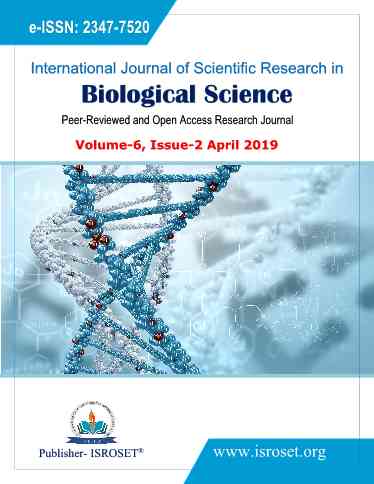Impact of Thiadiazole as Bombyx Mori Growth Enhancer
Keywords:
Diamines, Thiadiazoles, Bombyx mori, sericulture, Economic parameterAbstract
Sericulture or silk farming is the rearing of silkworms for the production of raw silk. The mulberry silkworm, Bombyx mori is a domesticated and monophagous insect which feeds only on the leaves of mulberry for its nutrition. In this study we investigated the growth and economic parameters of Silkworm, Bombyx mori (Lepidoptera: Bombycidae) by dietary supplementation of thiadiazole. Thiadiazoles are heterocyclic compounds containing oxygen and nitrogen. 1, 3, 4, thiadiazoles are extensively studied and are known to play diverse biological activities. Diamines or polyamines are found in various biological fluids and are necessary for optimal growth, replication and metabolism of every cell in the body. This report describes the synthesis of diamino substituted thiadiazole and its effect on the growth parameters of Bombyx mori silkworm. Results show that the thiadiazole resulted in increased worm weight, silk gland weight and cocoon weight. We conclude that the thiadiazole can be fed to Bombyx mori silk worms for improving their economic parameters.
References
Y. Ahsan, “Variability of some quantitative traits in the hybrids silkworm, Bombyx mori”, Journal of Sericultural Sciences, Japan, vol. 18, no. 5, pp. 299-301, 2006.
O. Itushi, “Silkworm nutrition on mulberry plantation in Tokyo”, J. seric.sci, Jpn; vol. 48, no. 8, pp. 282- 286, 2012.
A. Biram and H. Gowda, “Silkworm seed technology”. In Appropriate sericulture technique Central Silk Board, Bangalore, India, vol. 89, no. 4, pp. 590 –599, 2009.
H. Akai, K. Kiguchi and K. Mori, “Increased accumulation of silk protein accompanies KJH-induced prolongation of larval life in Bombyx mori L”. Applied Entomology and Zoology, vol. 67, pp. 218-220, 1971.
H. Akai, K. Kiguchi and K. Mori, “Influence of thiadiazole on the growth and metamorphosis of Bombyx larvae”. Bulletin of the Sericultural Experiment Station of Japan, vol. 32, pp. 287-305, 1973.
H. Akai and K. Kiguchi, “Ultrastructural changes of the posterior silk gland cells from the allata-ectomized 4th-instar larvae of Bombyx mori”. Bulletin of the Sericultural Experiment Station of Japan, vol. 28, pp. 1-14, 1981.
H. Akai, K. Kiguchi, Y. Kobari and A. Shibukawa, “Practical utilization of juvenoids for increasing silk production”. Scientific Papers of the Institute of Organic Physical Chemistry, vol. 22, pp. 781-792, 1981.
H. Akai, K. Kimura, M. Kiuchi and A. Shibukawa, “Effects of anti-juvenoid treatment on cocoon and cocoon filaments in Bombyx mori”. Journal of Sericultural Science of Japan, vol. 53, pp. 545-546, 1984.
L. Cappellozza, P. Ianne and S. Cappellozza, “Effect of body weight on effectiveness of the insect growth regulator (I.G.R.) thiadiazole applied to the male and female silkworm (Bombyx mori) (Lepidoptera: Bombycidae)”. Sericologia, vol. 37, pp. 443-452, 1997.
C.F. Chang, S. Murakoshi and S. Tamura, “Giant cocoon formation in the silkworm, Bombyx mori L. topically treated with methylenedioxyphenyl derivates”. Agricultural Biology and Chemistry, vol. 36, pp. 629-694, 1972
S.K. Chowdhary, F. Sehnal, S.K. Raj, P.S. Raju and S. Mathu, “Giant cocoon formation in Bombyx mori L. topically treated with juvenile hormone”. SJ-42-F. Sericologia, vol. 26, pp. 455-457, 1986.
Downloads
Published
How to Cite
Issue
Section
License

This work is licensed under a Creative Commons Attribution 4.0 International License.
Authors contributing to this journal agree to publish their articles under the Creative Commons Attribution 4.0 International License, allowing third parties to share their work (copy, distribute, transmit) and to adapt it, under the condition that the authors are given credit and that in the event of reuse or distribution, the terms of this license are made clear.







